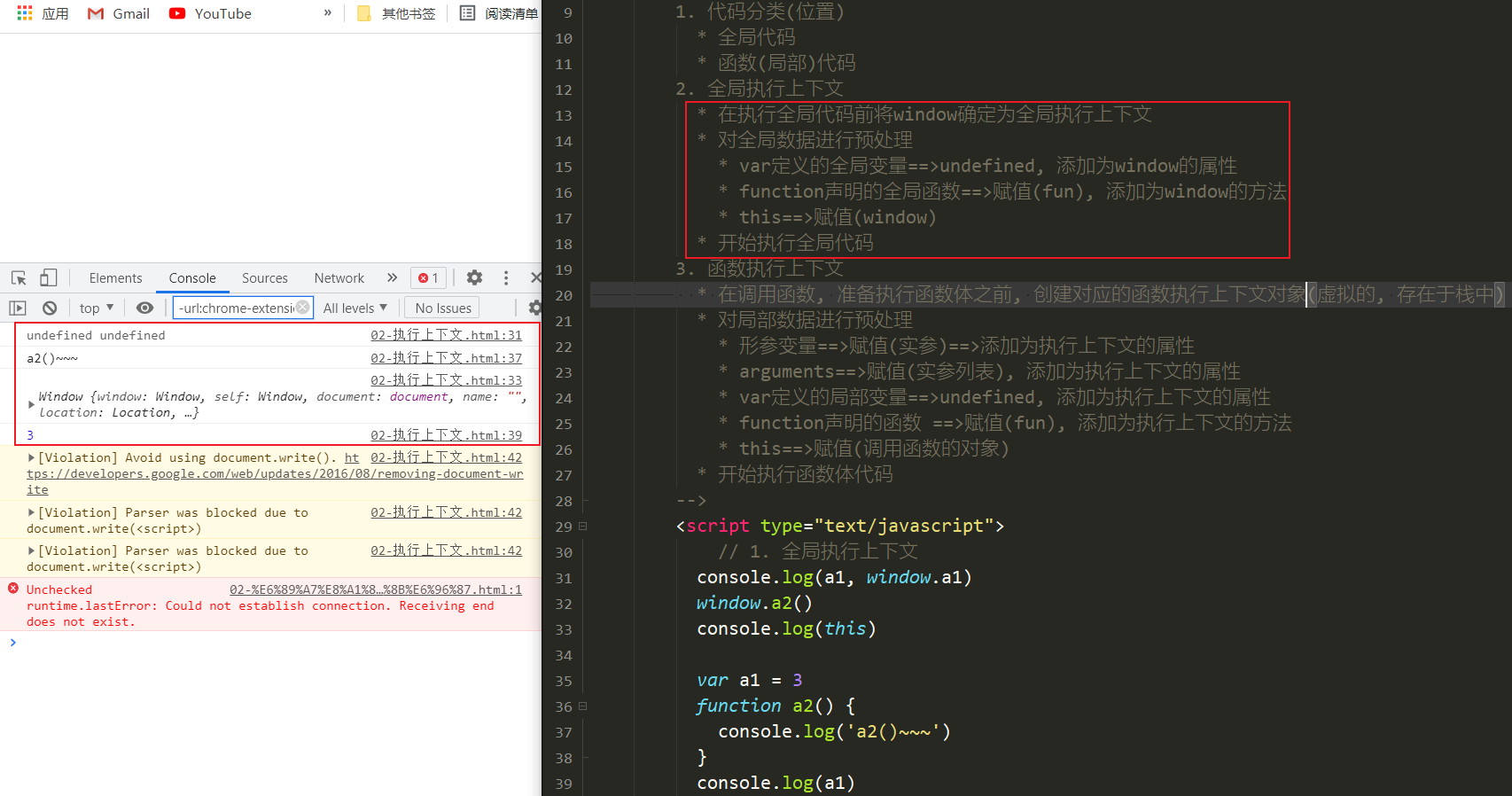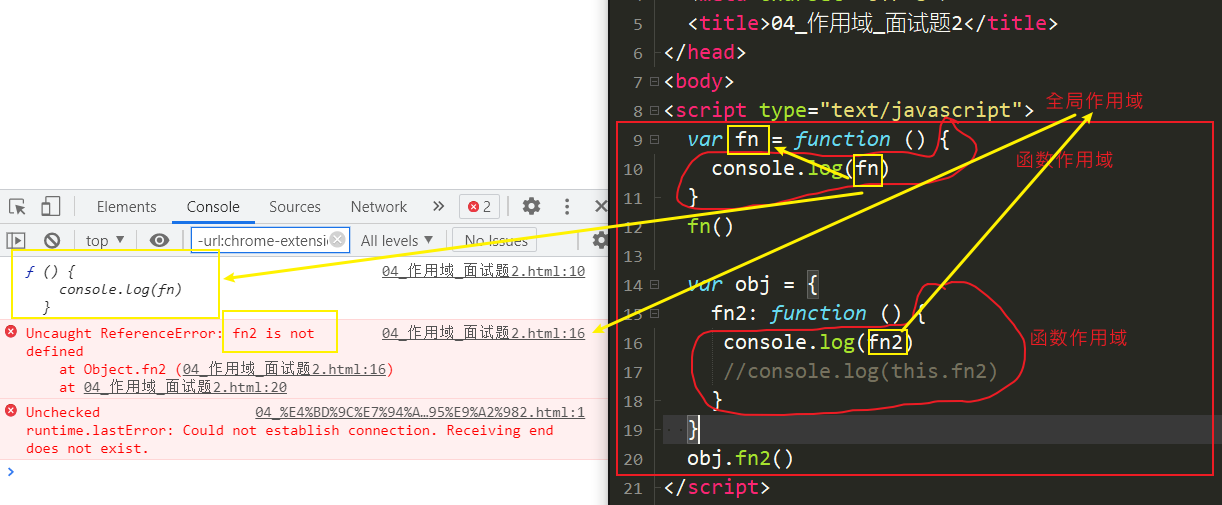0. Execution context and execution context stack
0.1 variable promotion and function promotion
- Variable promotion: this variable can be accessed before the variable definition statement
- Function promotion: the function is executed before the function definition statement
- First the variable is promoted, then the function is promoted

0.2 how to understand variable promotion and function promotion?
- Execution context: an object automatically created by the js engine, which contains all variable attributes in the corresponding scope
- Number of execution contexts: n (function called several times) + 1
- Global execution context

- Function execution context

0.3 execution context stack: used to manage multiple execution contexts generated
- Classification:
- Global: window
- Functions: transparent to programmers
- life cycle
- Global: generated before the global code is ready to execute, and dies when the page refreshes / closes the page
- Function: occurs when a function is called, and dies when the function is executed
- Which attributes are included:
- overall situation:
- Global variables defined with var = = > undefined
- Function declared with function = = > function
- this ===>window
- function
- Local variables defined with var = = > undefined
- Function declared with function = = > function
- This = = = > the object that calls the function. If it is not specified, it is window
- Formal parameter variable = = > corresponding argument value
- Arguments = = > pseudo array of argument list
- overall situation:
- Perform the process of Context Creation and initialization
- overall situation:
- Create a global execution context (window) before global code execution
- Collect some global variables and initialize
- Set these variables to the properties of window
- Function:
- When calling a function, create a function execution context before executing the function body
- Collect some local variables and initialize
- Set these variables as properties of the execution context

- overall situation:


0.3.1 execution context stack interview questions:

0.3.2 interview questions for variable promotion and function promotion:
Execute variable promotion first, and then function promotion

1, Scope and scope chain
- understand:
-
Scope: a code area that is determined during coding and will not change

-
Number of scopes: n (several functions defined) + 1

-




-
Scope chain: an inside out structure formed by multiple nested scopes, which is used to find variables
-
Classification:
- overall situation
- function
- js has no block scope (before ES6)
-
effect
- Scope: isolate variables. Variables with the same name can be defined in different scopes without conflict
- Scope chain: finding variables


-
Distinguish between scope and execution context
- Scope: static. It is determined during coding (not at runtime). Once it is determined, it will not change
- Execution context: dynamic. It is created dynamically when code is executed and disappears when execution ends
- Contact: the execution context is in the corresponding scope













2, Closure
2.1 understanding of closure:
- A closure occurs when a nested inner function references a variable of an outer function
- Through the chrome tool, we know that the essence of closure is an object in the internal function, which contains the referenced variable attributes
function fn1() {
var a = 2
var b = 'zep'
return function fn2() {
console.log(a)
}
}
var f = fn1()
f()

2.2 function of closure:
-
Extend the life cycle of local variables
-
Let the external function operate on the internal local variables
-
Write a closure program
function fn1() {
var a = 2;
function fn2() {
a++;
console.log(a);
}
return fn2;
}
var f = fn1();
f();
f();
2.3 common closures



// Common closures:
/* // 1. Take a function as the return value of another function
function fn1() {
var a = 2
function fn2() {
a++
console.log(a)
}
return fn2
}
var f = fn1()
f() // 3
f() // 4
// How many closure functions (i.e. fn2()) are created?
// Look at how many times the external function is executed, that is, how many times fn1() is executed */
// 2. Pass a function as an argument to another function call
function showDelay(msg, time) {
setTimeout(function() {
alert(msg)
}, time)
}
showDelay('zep', 2000)

2.4 life cycle of closure:

2.5 closure application:
-
Modularity: encapsulate some data and functions that manipulate data, and expose some behaviors to the outside
Mode 1:

Mode 2:


-
Loop traversal plus listening



// Requirement: click a button and prompt "click the nth button"
/* var btns = document.getElementsByTagName('button')
// Traversal plus listening
for(var i = 0, length = btns.length; i < length; i++) {
var btn = btns[i]
// Save the subscript corresponding to btn to btn
btn.index = i
btn.onclick = function() {
alert('The '+ (this.index + 1) +' th ')
}
} */
var btns = document.getElementsByTagName('button')
// Traversal plus listening
for(var i = 0, length = btns.length; i < length; i++) {
// Using closures
(function(i) {
var btn = btns[i]
btn.onclick = function() {
alert('The first' + (i + 1) + 'individual')
}
})(i)
}
- The JS framework (jQuery) makes extensive use of closures
2.6 disadvantages of closures:
- Variables may take too long to occupy memory
- May lead to memory leakage (the released memory is not released in time)
- solve:
- Timely release: f = null// Make internal function objects garbage objects
How to determine whether closures exist?
The following three points need to be met:
- Function nesting exists
- The variable defined in the parent function is referenced (used) in the child function
- The parent function was called and executed
For example, in the following code,

Because closures can keep n variables in memory, and a variable points to the return value of fun(0) (the return value is also a function, and there is a closure in the function. The closure is an object, and the object contains the referenced variable attribute, i.e. n variables), the return value will not be automatically destroyed as a garbage variable, There is a problem: closures can lead to memory leaks
2.7 closed surface test questions

//Code snippet 1
var name = "The Window";
var object = {
name: "My Object",
getNameFunc: function() {
return function() {
return this.name;
};
}
};
console.log(object.getNameFunc()()); //? the window
//Code snippet 2
var name2 = "The Window";
var object2 = {
name2: "My Object",
getNameFunc: function() {
var that = this;
return function() {
return that.name2;
};
}
};
console.log(object2.getNameFunc()()); //? my object


3, Memory overflow and memory leak
- out of memory
- An error in the operation of a program
- When the memory needed by the program exceeds the remaining memory, a memory overflow error is thrown

- Memory leak
- The occupied memory was not released in time
- Excessive accumulation of memory leaks can easily lead to memory overflow
- Common memory leaks:
- Unexpected global variable
- Timers or callback functions that are not cleaned up in time
- closure
